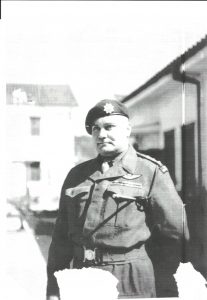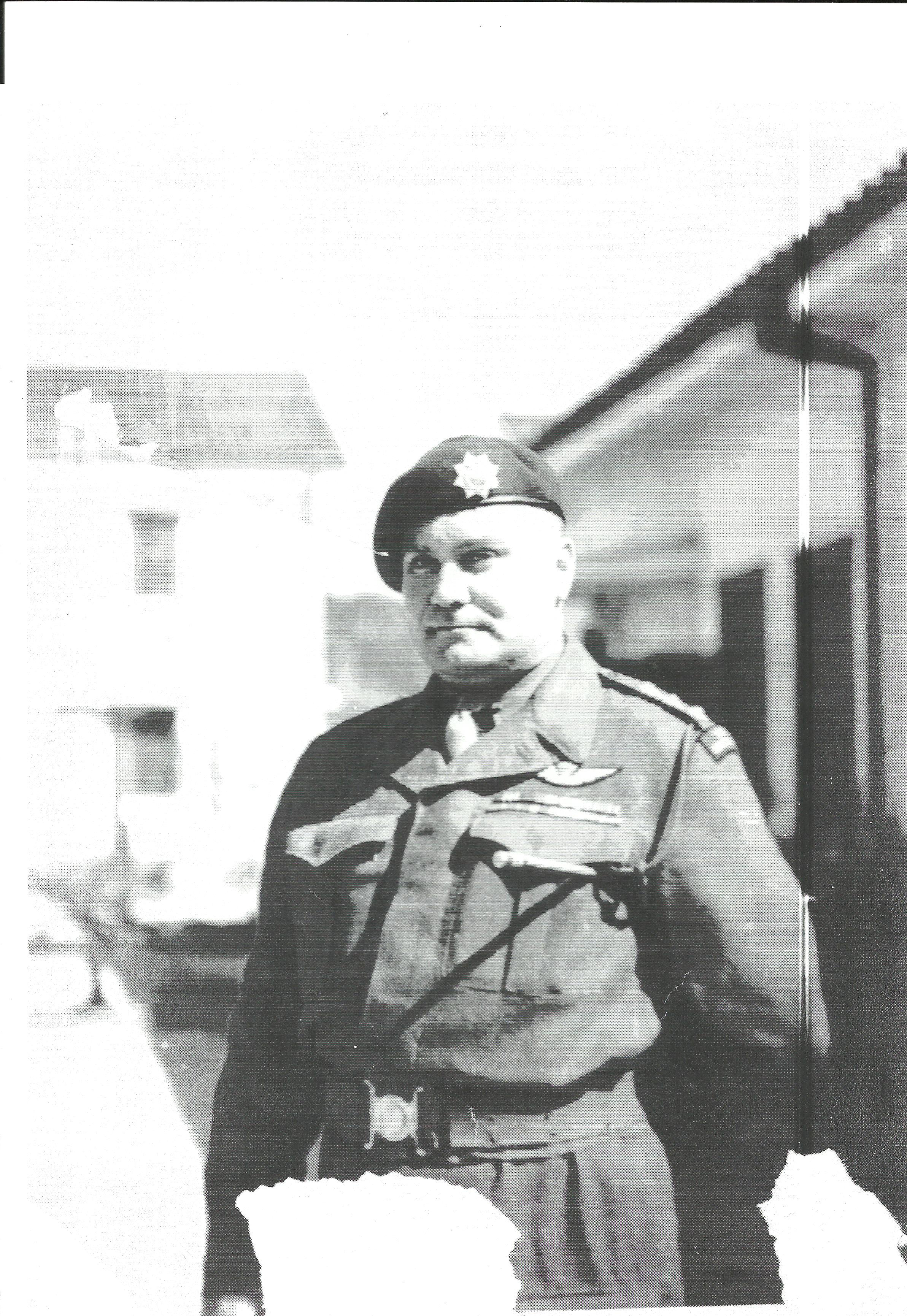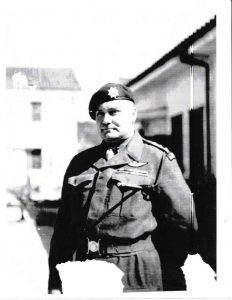
| Rank | Lieutenant (MM), Sergeant, Major |
| Service # | S271 |
| Unit # | Royal Canadian Regiment |
| Resident | Chatham |


Edward enlisted in September of 1939 in London with the RCR. and went overseas in late 1939. At the time of Edward being taken as a POW it is believed that his rank was Sgt.
“ESCAPE”
by
Lieut. E. F. CARRON MM.
Transcribed by J. R. Hind Nov. 2010.
This is an attempt to portray to the readers some of the various experiences of an escaped P.O.W.
At the time of the invasion of Sicily the writer was PL. [platoon] Sgt. of 9PL. “A” Coy. [company] then commanded by Captain (now Major) R. G. Liddell, M.B.E.
Late the afternoon of 2 Aug. 1943, the Germans had counter-attacked the “Hampshires” (a battalion of the 23 Malta Bde. Which was an independent Imperial Bde. working with us, and had driven them back some distance retaining command of Regalbuto and the high features north-west of it.
The troops moved forward; we learned that it was our job to take by stealth and hold these three prominent high features. Should we run into difficulties we were to fall back and at dawn the 25’s [25 lb. artillery] would plaster our objectives, softening up Jerry [slang for German troops] for us.
“A” Coy. Moved forward, picking their way through the town which was supposed to have been cleared and finally passing through “B” Coy. At the foot of a small cliff which terminated in the first high feature. At this time we came under L.M.G. [light machine gun] fire, and a moment later the gun on a tank started blasting down the street, it seemed we were to have quite a warm welcome. The Coy. Comd. [commander] after determining where the fire was coming from sent a Pl. around in a left flanking movement to silence the tank gun.
As we started off we heard the Coy. Comd. Fire at some characters, however as we picked our way through and up to the cliff the firing slackened off somewhat. The Pl. Sgt. was leading the point section and after scaling the cliff we found ourselves in a position to assault the high feature which had a small tower affair on the summit. At this point we came under fire from 2 Brens [Bren light machine-gun] from our right flank! At the moment we roundly cursed our sister Pl. for firing on us; however later we found that the fire had come from captured weapons.
We assaulted the hill, took the little tower and had the feature. Now if all had gone well, the other Coys. would have moved through us to strengthen and consolidate our position.
However the tank was still firing on the other Pls. of the Coy. so something had to be done quickly.
The Pl. Comd. knowing that speed was essential took two sections and went after the tank, Pl. Sgt. with 1 section went about clearing the position. It should be mentioned here that as all thing take time, it was very close to first light by now. After the initial surprise the Germans started to feel out our positions and apparently was fully aware of our low numbers.
At dawn down came the 25’s ranging I believe on the tower. The Pl. Comd’s runner, coming back to tell the Sgt. to fall back, was captured. First light came with an isolated section of 9 Pl. far forward of any support. With light we saw that the town was occupied in strength, on our right were dug in tanks hull down on the reverse slope, on the left a “42” [MG-42 German machine gun] started to make things uncomfortably warm. About this time the Pl. Sgt. made a quick dash into the tower and climbing up the circular staircase for a good O.P. [observation post] – a round of A.P. [armour piercing] coming through the tower from a dun-in tank however made it not the ideal spot to terry.
Rejoining the section the pl. Sgt. found that his Bren group had been over-run and by now the remainder of the section was completely cut off and Jerry with the odd pasting of our own 25’s to help out, made the situation appear rather dark brown, and finally, with no help forthcoming, and his tanks, captured Brens and 2 M.G. 42’s to support him Jerry over-ran our position and we found ourselves P.O.W. [prisoners of war] The CDN 1/09/43(P) reported that Sgt. E. Carson was reported a MIA.
We were quickly taken well back and bundled into a P.O.W. cage. Here we were fortunate enough to get treatment for our three wounded men and get them taken off to hospital. Later one of these Grigas (D.C.M.[Distinguished Conduct Medal] – the Bren gunner) and a chap Rocke (who was sent back about the same time with a bad case of dysentery) managed to escape and made their way back through the British lines.
Shortly after we were machine-gunned by our own planes and a Britisher and two Americans killed.
In Messina, during the confusion by another air-attack, we managed to escape, but we were recaptured shortly after taking a wounded companion into a first aid station.
Our next stop was Capua (P.G. 66) where we escaped again – getting clear for two days before recapture.
Again we managed to give them the slip while being marched through the streets of Capri to P.G. 73; but the foolish behaviour of our fellow P.O.W. led to our recapture as we were no match for the Germans in our weakened condition. Here it might be mentioned that our RATIONS left a great deal to be desired; my own weight having dropped from 210 to 164.
However, our mistakes had taught us that we must make more through preparations for our next break to ensure a clean get-away.
The following night while en route to Germany in freight cars we decided to try again. A few handfuls of pebbles in the toe of a army sock makes a very effective cosh; so with the guard out of the way we had only to kick the barbed wire from the ventilator, wait for complete darkness, get around the outside guard and jump. Again we had forgotten one factor, the speed of the train! My companion was stunned landing however with luck I dragged him clear of the track.
Getting our bearings we found that we were on the edge of an airfield. Here unguarded we found five planes; with nothing but a crude knife we sabotaged them so they would crash in flight. This was rather easy with the three which had a stressed fabric covering. However the transports were more difficult.
As it not long before day break we were soon on our way luck seemed to be with us for we got clear without mishap.
From our previous attempts we knew that is was essential to get into civilian clothing as soon as possible to cross the Po [river] with any hope of success.
Later we again made our way north, into the foot-hills of the Alps. Passing through such small towns as St. Pedro and Capo de Ponte, we made our way to the Pass D’ Apligar which was the only unguarded spot at which we could cross the Alps successfully.
During this time it was necessary to travel during the hours of daylight as the country was under curfew and the Germans permitted no civilian movement at night.
Finally when only a few miles from the Swiss border we waited for a foggy night and crossed without too much trouble.
In Switzerland we were called Internees but were allowed all privileges of the Swiss Army and certainly not kept under custody or anything of that nature.
We were organized much as a large detached unit with Officers, N.C.O’s and men from every country in the Empire. We, of course, were allowed no military training, but got around that by calling a route march and organized walk, or a stipulated place of parade a rendezvous, etc.
With the landing in Normandy and the American landings south, some of us made our way through Belfort area thence with Americans to Marseilles. From there by Lyons, Paris, we soon found our way back to the UK.
Pro Patria.
Award of MILITARY MEDAL
TO
Sergeant Edward Francis CARRON.
Canadian Infantry Corps.
Three days after his capture at Regalbuto, Sicily, Sergeant Carron escaped during the bombing raid but was recaptured when securing Capula and Carpi (Camp 73). On 14 September 1943 he and other non-commissioned officer slipped away from the column of prisoners being marched to the station for entrainment for Germany. However the foolish behavior of the other prisoners led to their immediate recapture. There-after they were closely watched until they boarded the train.After breaking the barbed wire covering the small ventilator they climbed on to the buffer plate and jumped while the train was proceeding rapidly. His companion was knocked unconscious, but Sergeant Carron, disregarding his own safety, dragged him clear of the wheels of the train. Shortly afterwards Sergeant Carron seeing five enemy aircraft on the ground, left the injured man to the care of his other companion and sabotaged the planes so that they would crash in flight. He soon rejoined his friends and the three men walked to Switzerland, finally crossing the frontier on 25 September, 1943. It was mainly through the efforts of Sergeant Carron, who incidentally knew no Italian that food was secured during the journey.
Transcribed from a copy of the original citation by J. R. Hind. – copy on file.
Edward would remain in the the Army after WWII. He earned his paratrooper wings and did winter warfare training at Fort Churchill, Manitoba. He would serve with UN peacekeeping forces in the Middle East in the early 1960’s. He would eventually retire from the service in 1967 with the rank of Major.
The CDN 16/12/44(P) reported that WO., CARRON, E. C. Of Pain Court. Reported on his way home on 30 days leave. And he arrived CDN 16/01/45.

ADDITIONAL INFORMATION
| Awards | M.M. |
| Sources | CDN (24-09-1945 16/12/44/ 11/11/10,), LM-LP, T. G. Carron (son) email 25/01/18 |
| Supplemental Information | The son of S. F. Carron of Paincourt |
Notice something wrong with this record? Or, do you have something to add? Report it using our online form.


